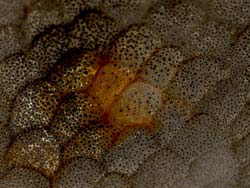New discovery: Plaice are spotted (on the inside)

The spotted skin of a plaice. <br>Photographs: Helen Nilsson Sköld<br><br>
Many species of animal have skin or fur with intricate pigmentation patterns, which they use for camouflage, communication, regulation of body heat and protection against the sun. A study conducted by researchers at the Department of Marine Ecology at the University of Gothenburg has found that several species of fish also have highly-coloured internal pigmentation.
Adapts to its surroundings
In a study published in Pigment Cell & Melanoma Research, marine biologist Helen Nilsson Sköld and her colleagues show that the number of internal pigment cells has a direct link to the degree of transparency of the fish. Transparent fish can change colour using their internal pigment cells, thus enhancing external skin pigmentation and their ability to adapt to the background colours of their surroundings.
Bewildering display of colour
Mysteriously, plaice also have a high number of internal pigment cells in, for instance, the ear and brain and around their internal organs. Plaice however are not particularly transparent. The internal pigment cells of this fish cannot be seen easily from the outside, which makes its internal display of colour somewhat bewildering.
Unknown functions
According to Helen Nilsson Sköld and her colleagues, the fact that less transparent fish also have this internal pigmentation indicates that the pigment cells may have other, as yet unknown, functions.
“We believe that the internal pigment cells either function as vessels for excess pigment or perhaps provide various forms of protection or contribute to the immune system. We hope to investigate this subject further,” says Helen Nilsson Sköld.
Contact:
Helen Nilsson Sköld, Department of Marine Ecology,
University of Gothenburg
+46 (0)706 827391.
helen.skold@marecol.gu.se
Media Contact
More Information:
http://www.gu.se/All latest news from the category: Life Sciences and Chemistry
Articles and reports from the Life Sciences and chemistry area deal with applied and basic research into modern biology, chemistry and human medicine.
Valuable information can be found on a range of life sciences fields including bacteriology, biochemistry, bionics, bioinformatics, biophysics, biotechnology, genetics, geobotany, human biology, marine biology, microbiology, molecular biology, cellular biology, zoology, bioinorganic chemistry, microchemistry and environmental chemistry.
Newest articles

High-energy-density aqueous battery based on halogen multi-electron transfer
Traditional non-aqueous lithium-ion batteries have a high energy density, but their safety is compromised due to the flammable organic electrolytes they utilize. Aqueous batteries use water as the solvent for…

First-ever combined heart pump and pig kidney transplant
…gives new hope to patient with terminal illness. Surgeons at NYU Langone Health performed the first-ever combined mechanical heart pump and gene-edited pig kidney transplant surgery in a 54-year-old woman…

Biophysics: Testing how well biomarkers work
LMU researchers have developed a method to determine how reliably target proteins can be labeled using super-resolution fluorescence microscopy. Modern microscopy techniques make it possible to examine the inner workings…





















